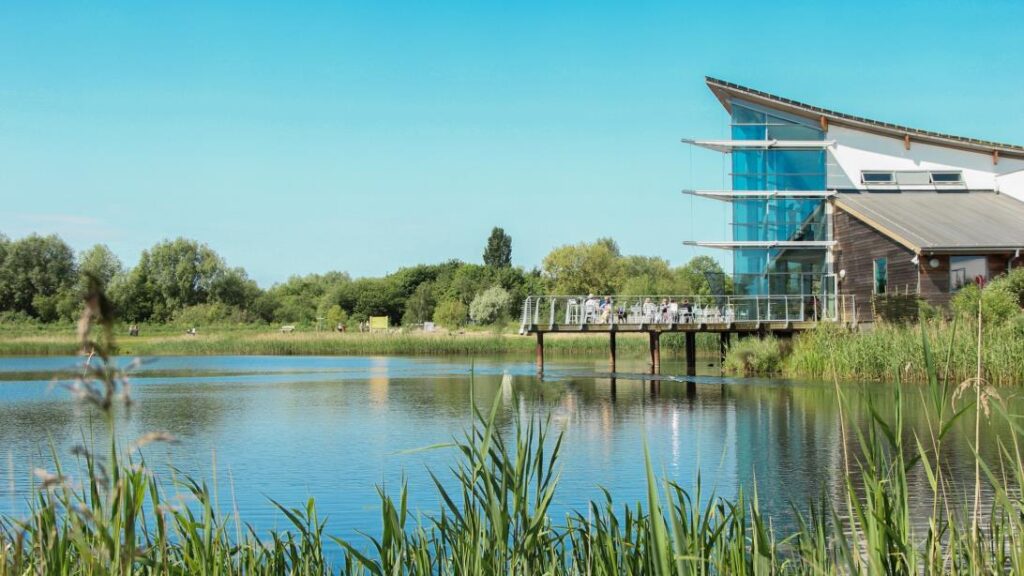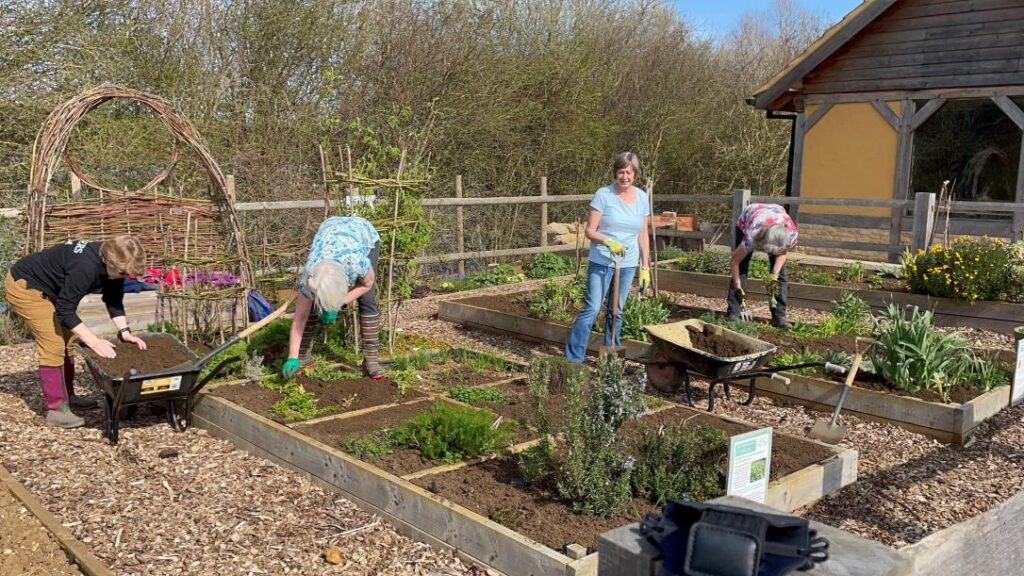Stanwick Lakes Heritage Garden, Northamptonshire, Unforgettable Garden of the Month, nominated by Elaine Johnson of Northamptonshire Gardens Trust
Stanwick Lakes is a unique 750-acre nature reserve in the heart of the Nene Valley, run by the Rockingham Forest Trust. Over the last four years a Heritage Garden and Wellbeing Orchard have been constructed there, part of a Community Heritage Lottery-funded project to give visitors a glimpse into the history of the site.
Unforgettable Heritage Garden

Although different from many of the historic gardens and landscapes featured in this series, the Stanwick Lakes Heritage Garden is an unforgettable example of those gardens which have been created to show plants or designs from the past. It showcases heritage plants in an authentic setting and provides hands-on opportunities for volunteers to learn about ancient plants and garden maintenance.
History
Stanwick Lakes nature reserve is a Site of Special Scientific Interest (SSSI), meaning that it is one of the best wildlife and geological sites in the country. It supports plants and animals that find it more difficult to survive in the wider countryside. There are 17 miles of footpaths allowing visitors to enjoy the abundant wildlife and plants around its beautiful lakes, riverbanks and woodland.
The lottery-funded project at the Nene Valley site included creating a replica Iron Age Roundhouse and a Heritage Barn. These were built using different ancient building techniques, with the help of the local community. There is also an actual Roman mosaic on display, found during excavation of the site in the 1980s. The Heritage garden is alongside the barn, now a focal point at Stanwick Lakes and used for all sorts of activities and workshops.

Members of Northamptonshire Gardens Trust, particularly Michael Brown, Elaine Johnson and Jenny Burt, helped Rockingham Forest Trust to create a wish-list of pre-medieval plants and develop a planting plan, as well as donating plants to get them started.
Heritage plants
The design features seven themed raised beds planted with fruit bushes, annual vegetables, herbs, roses, plants for dyeing and decorative plants. The fruit bushes chosen include raspberries, which would have been foraged by Stone Age settlers, blackcurrants and gooseberries. Vegetables such as purple carrots, leeks, carlin peas, fava beans, onions, garlic and parsnips reflect those that were available before modern varieties – like orange carrots – were introduced. Bay, germander, sage, thyme, lavender, parsley and fennel were important herbs both for the kitchen and medicinal use.

The rose bed features the Damask Rose (Rosa Damascena), which was brought back to this country from Damascus in 1148 by the Crusaders, and the Apothecary’s Rose (Rosa Gallica Officinalis) which was very common in medieval gardens. Self-seeded Love in a Mist (Nigella Sativa) makes a lovely background to the roses. Madder plants were used to produce red dye, weld for yellow dye and woad for blue dye. The decorative flower bed has stocks, wallflowers, hollyhocks, aquilegia, hellebores, irises, borage, valerian and the striking Dragon Plant (Dracunculus vulgaris). This has fabulous deep burgundy flowers once a year in late June/early July which smell like rotting meat. The backdrop to the garden is a bed planted with a hedge of sweet briar rose, dog rose and butchers broom, under-planted with primroses and cowslips, catmint, chamomile, ox-eyed daisies, meadowsweet and St John’s wort.
Wellbeing Orchard

In the second year of the project, after amazing feedback from visitors, Rockingham Forest Trust built a wellbeing orchard, planted with heritage varieties of apple, pear, quince and medlar. Under the fruit trees are wild flowers, and the orchard is surrounded by a new native British hedge. Visitors and volunteers love to sit in quiet contemplation, enjoy the sounds of nature and the lapping water from the nearby lake, and admire the blossom and wildflowers.
Current Status
The Heritage Garden has been made possible by the passionate commitment of the amazing volunteer team who have helped to create and maintain the gardens over the past few years, through lockdowns and social distancing. Northamptonshire Gardens Trust continue to work with them, doing garden talks and supporting the Rockingham Forest Trust team at open days and events, so they can share the fascinating history of plants with the community and visitors.

Workshops for volunteers have allowed them to develop new skills, such as those needed to build traditional cleft fencing, which is used around the garden, willow weaving to make obelisks, and making bug hotels to encourage insects into the garden. New flowers introduced into the area have also attracted insects and wildlife, helping to support the SSSI status of Stanwick Lakes.
The funded project has now come to an end, but the heritage barn and gardens remain as a legacy to be enjoyed by visitors for years to come. They will continue to tell the story of just how important plants have been to settlers who have lived in the Nene Valley for over 10,000 years. A story worth telling and a garden worth looking after!
Becky Gill, Heritage Manager
Rockingham Forest Trust
To volunteer at the Heritage Garden contact Becky Gill
Northamptonshire Gardens Trust
Find out more about our campaign to highlight the many unforgettable gardens we all treasure.



